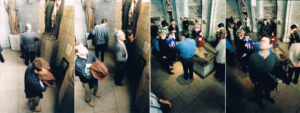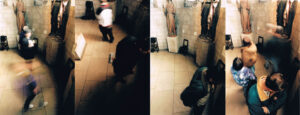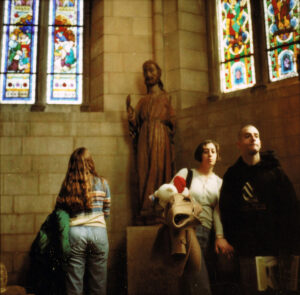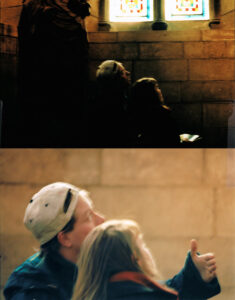This series of photographs directly refers to the village of Bad St. Leonhard, its history and residents. I followed the historic track of the gothic glass windows of the pilgrim-church, forged and molded in the early decades of the 14th century. Bad St. Leonhard im Lavanttal is a little village in Carinthia, Austria, very near to where I grew up. The tower of the church burnt down twice, and in order to restore the damage, seventeen glass panels were sold in the 1930ies to an art collector in the United States of America. They ended up at The Cloisters, part of the Metropolitan Museum of Art in New York, where I came across them. I was intrigued and decided to do a piece about these gothic panels and their new geographical home in order to capture them in their present setting, far away from the place they were designed and conceived for. At the Cloisters they are now exhibited in a reconstructed chapel together with other art objects, in a new context and for a different public and purpose.
I am interested in the art object and its initial purpose, the material it is formed of, the intrinsic logic of that choice, and also its transformation over time as its physical place and its function are altered. First, these panels were marveled at by pilgrims and visitors with a religious intention. One can see them as a device to convey knowledge while serving an architectural and decorative goal. 500 years later they are transformed into an art object, dated, commented, numbered, and eventually archived, admired – or disdained – as a cultural value, a remnant of a historical relevance of an era.
I was interested in tracing an object through time, in this case a specific and prestigious object associated with a certain value, faith and fetishism, but it could also have been a toothbrush, a keychain or sneakers. I was curious about the course of events, of retracing and visualizing a stretch of time and reconstructing it mentally, like a memory recalled, a conscious perception of time. I am amazed at how time, space and circumstances change the definition and purpose of an object over and over again, and I wonder to what extend this is influenced by how we look at it, and who is looking. As we humans are confronted with artefacts of a different time and region, we are challenged by the inexplicable and the intangible, in a space called museum, in which we enter contemplatively, serene, just like we did before in places of worship, temples and churches; in search for the true, the beautiful or other answers… In choosing to ‘portrait’ the glass panels, I wanted to get in contact with the viewers of the photographs in Bad St. Leonhard, to tickle his or her sense of curiosity: is there an immediate connection, an identification because of the same place of origin? Most of the photos are enlarged to human size, so the people in the photos are more or less the size of the people looking at them. The shots are like a sketch book, a travel diary that intends to enable a glimpse into the atmosphere of that new place and a mental travel through time.
Concept: Christina Clar
Raiffeisenkasse of Bad St. Leonhard (Austria), 1998














































